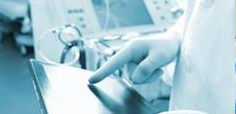Efficient and compliant medical device development and production

Editor’s note: A German version of this article, “Entwicklung und Produktion von Medizingeräten mit Effizienz und Konformität – Agil und sicher,” also appears on the blog. Click here to read it.
Agility to benefit business and patients alike
Doctors, therapists and patients expect perfect medical products. They should be simple, effective and safe to use.
The pressure to innovate is at least as high in the medical equipment industry as in any other industry.
On the one hand, manufacturers are trying to be first to get products supporting promising new treatment methods out to the market. On the other hand, healthcare usually depends on public financing, which implies an enormous pressure on costs.
Strict medical device development documentation requirements
Certification procedures in the medical equipment industry are as stringent as those in the aerospace industry. The applicable FDA regulatory requirements for the United States and ISO standards for the rest of the world require manufacturers to supply complete, continuous records detailing not only the final product definition, but also the processes used in development and production.
These records are required to describe how each product and production functionality is realized, as well as to describe how the fulfillment of each functionality has been proven in verification and in validation testing.
Since the publication of the revised ISO13485:2016 standard, and the new EU-Medical Device Regulation issued on May 05, 2017, medical device manufacturers, as well as all companies involved in their development, production and sales, must provide this evidence as a Design History File, a Device Master Record, a Device History Record, and a Technical File and other standardized records.
Consider better medical device development processes
Requirements for medical device innovation and agility on one hand, and risk avoidance and traceability on the other hand, appear to be mutually exclusive at first sight. However, achieving sustained success on the medical technology market requires the ability to meet both of these competing objectives.
Fulfilling stringent regulatory record-keeping requirements adjacent to the product development process is an unproductive yet rather costly sideline activity. Its complex internal communication makes it difficult to avoid inaccuracies and synchronization errors. A documentation team detached from the development and production that creates the records required for certifications is therefore less than expedient.
Successfully combining a fast innovation rate with fulfilling extensive record-keeping and certification requirements is only feasible if the required records need not be compiled separately. They need to be automatically created during development, testing and production as a by-product in the software systems used at each step.
This starts at requirements for intended product use, complete with testing methods and results. It includes the objectives, methods and solution paths used during development and production, and it reaches past commissioning and maintenance procedures, all the way to a disposal plan.
Sole comprehensive supplier
No single software system on the market can fully cover all these medical device development requirements. But with a portfolio of software packages that are different and can be optimized for interaction between them, Siemens can consistently cover the entire product lifecycle from the initial idea to all phases of development, test and production to commissioning and after-sales support.
The Siemens software portfolio that’s relevant to medical equipment manufacturers comes in three main segments:
- Fully integrated product development and manufacturing
- Verification and validation across the entire product life cycle
- Active process and results management
Contact us if you’re in the medical industry and want to learn how our solutions could help improve your business.


